World War II
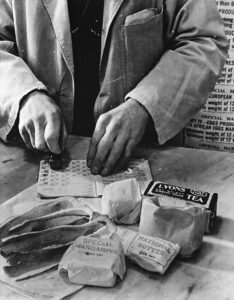
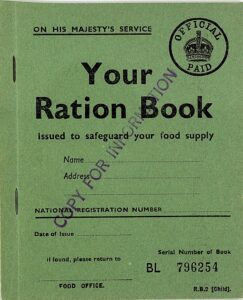 When my dad, Staff Sergeant Allen Spencer, was serving in the Army Air Force during World War II, rationing was not an unusual thing. Nevertheless, most of us think of rationing to be in the form of gas rationing. That is pretty much the kind of rationing we have heard being used these days, but on January 8, 1941, the government of the United Kingdom began a different kind of rationing…food. I can see the value of such a thing, because by limiting the amount of food each person could have, they could ensure that everyone was able to get enough food to sustain them. People weren’t going to gain weight on the amount of food allowed, but they could survive. I suppose the fact that there were so many extra people, in the form of the military forces, just added to the need to ration.
When my dad, Staff Sergeant Allen Spencer, was serving in the Army Air Force during World War II, rationing was not an unusual thing. Nevertheless, most of us think of rationing to be in the form of gas rationing. That is pretty much the kind of rationing we have heard being used these days, but on January 8, 1941, the government of the United Kingdom began a different kind of rationing…food. I can see the value of such a thing, because by limiting the amount of food each person could have, they could ensure that everyone was able to get enough food to sustain them. People weren’t going to gain weight on the amount of food allowed, but they could survive. I suppose the fact that there were so many extra people, in the form of the military forces, just added to the need to ration.
Of course, some food rationing occurred before this date too. Rationing was introduced temporarily by the government of the United Kingdom several times during the 20th century, during and immediately after a war. At the start of World War II in 1939, the United Kingdom was importing 20 million long tons of food per year, including about 70% of its cheese and sugar, almost 80% of its fruit and about 70% of its cereals and fats. It also imported more than half of its meat and relied on imported feed to support its domestic meat production. The civilian population of the country alone, was about 50 million. It was one of the principal strategies of the Germans in the Battle of the Atlantic to attack shipping bound for Britain, restricting British industry and 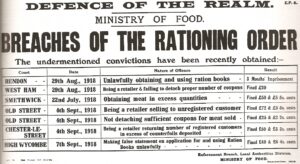 potentially starving nations into submission. Siege tactics were not unusual and have been used throughout history by several countries.
potentially starving nations into submission. Siege tactics were not unusual and have been used throughout history by several countries.
So, to deal with the various forms of shortages, and sometimes extreme shortages, the Ministry of Food instituted a system of rationing. Basically, the Ministry of Food would buy most rationed items, forcing anyone who wanted some of these items to register at chosen shops. Upon registration, they were provided with a ration book containing coupons. The shopkeeper was provided with enough food for registered customers. Purchasers had to present ration books when shopping so that the coupon or coupons could be cancelled as these pertained to rationed items. Rationed items had to be purchased and paid for as usual, although their price was strictly controlled by the government and many essential foodstuffs were subsidized. Basically, rationing restricted what items and what amount could be purchased, as well as what they would cost. To make matters worse the items that were not rationed could be scarce, because the Ministry of Food did not purchase said items. The priced for some of the unrationed items were also controlled by the Ministry of Food, and for many people those prices were too high for them to be able to afford, causing people to try to cheat the system, and merchants to try to either assist the people or to gouge the public in order to make a buck. This brought penalties for 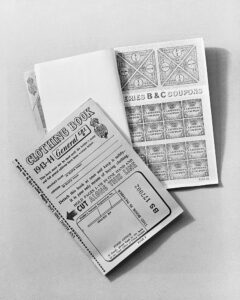
 breaking the laws of rationing.
breaking the laws of rationing.
During the World War II, rationing was not restricted to food, and was part of a strategy including controlled prices, subsidies, and government-enforced standards. The goal for this controlled pricing and rationing was to manage scarcity and prioritize the armed forces and essential services with the supplies they needed first. They did still try to make available to everyone, an adequate and affordable supply of goods of acceptable quality. I suppose that how well they accomplished their goal, would be a matter of opinion. Of course, like all wars, World War II ended, as did the rationing of the time, but rationing has returned a number of times, and will again, should the need arise.
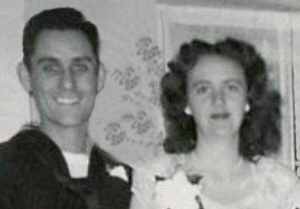
 My uncle, George Hushman was a handsome man, and I’m sure that was what first attracted my aunt, Evelyn (Byer) Hushman to her future husband. I’m also sure that Uncle George was just as taken with Aunt Evelyn’s beauty. They never had eyes for another after that. Uncle George had been raised at the Orphaned Children’s Home in Casper, Wyoming, and really what he craved most, was a family he could call his own. He had some good friends, including my son-in-law, Kevin Petersen great uncle, who sadly was lost at sea during World War II. Still, Uncle George maintained his relationship with the family for many years to come, even calling Kevin’s great grandma, Hettie Saint John, his grandmother, as did his children. Nevertheless, the Byer family would become his own family, when he married my Aunt Evelyn on September 1, 1947, after his own service in the Navy and World War II ended.
My uncle, George Hushman was a handsome man, and I’m sure that was what first attracted my aunt, Evelyn (Byer) Hushman to her future husband. I’m also sure that Uncle George was just as taken with Aunt Evelyn’s beauty. They never had eyes for another after that. Uncle George had been raised at the Orphaned Children’s Home in Casper, Wyoming, and really what he craved most, was a family he could call his own. He had some good friends, including my son-in-law, Kevin Petersen great uncle, who sadly was lost at sea during World War II. Still, Uncle George maintained his relationship with the family for many years to come, even calling Kevin’s great grandma, Hettie Saint John, his grandmother, as did his children. Nevertheless, the Byer family would become his own family, when he married my Aunt Evelyn on September 1, 1947, after his own service in the Navy and World War II ended.
Since my parents, Allen and Collene Spencer (Aunt Evelyn’s sister) were always close, the two families spent a lot of time together. I got to know Uncle George very well. He was a soft-spoken man who always made us feel welcome in their home. The living room of their home, which they and the rest of the Byer family built, had an unusually large front window area. It was more than a bay window. There was room for a bunch (maybe even 10) little kids to play behind those curtains, and the window gave us all the light we needed to see and have a playhouse atmosphere. Our playing and laughter never seemed to bother the parents, or if it did, they didn’t show it. Maybe it was the fact that we weren’t bothering them that made the difference.
The two couples did many things together, including bowling, and it was probably their bowling that got my sisters and me interested in bowling. I have been bowling now for 45 years…probably longer than anyone in my family, and maybe both families, and it all started with my parents, Uncle George, and Aunt Evelyn. I’m sure 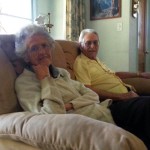
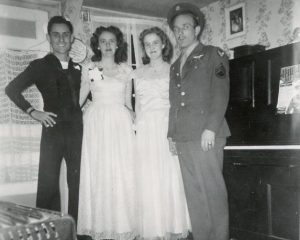 that for the two couples, bowling was a nice night out, and it wasn’t too costly either. Of course, eventually, most couples decide they have had enough of bowling, and it’s time to let the younger generation have a go at it. So, as the saying goes, they just “picked up their toys and went home.” That seems to happen at a certain age…some people take longer than others. I am proud of all the years they bowled, and thankful for the fun they passed on to us. Today would have been my Uncle George’s 97th birthday. Happy birthday in Heaven, Uncle George. We love and miss you very much.
that for the two couples, bowling was a nice night out, and it wasn’t too costly either. Of course, eventually, most couples decide they have had enough of bowling, and it’s time to let the younger generation have a go at it. So, as the saying goes, they just “picked up their toys and went home.” That seems to happen at a certain age…some people take longer than others. I am proud of all the years they bowled, and thankful for the fun they passed on to us. Today would have been my Uncle George’s 97th birthday. Happy birthday in Heaven, Uncle George. We love and miss you very much.
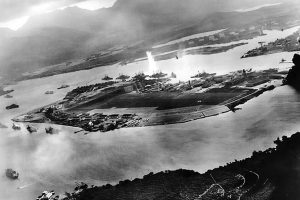
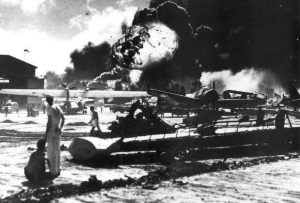 There are some national events that stay in our thoughts and hearts forever. The Pearl Harbor is one of those events. The attack on Pearl Harbor was so destructive and so unexpected that it shocked everyone…well, most everyone anyway. President Franklin D Roosevelt knew that Japan would likely attack, but thought it would be in the western Pacific Ocean, especially the Philippians. Pearl Harbor was considered an unlikely target. Roosevelt wanted to enter the war, but he wanted to attack Germany, whom he considered to be the bigger threat. In fact, he had ordered the attack on any U-Boats found in the west side of the Atlantic. So, technically the US was already in the war…most people just didn’t know that. Still, the attack on Pearl Harbor was horrific and the United States had to retaliate.
There are some national events that stay in our thoughts and hearts forever. The Pearl Harbor is one of those events. The attack on Pearl Harbor was so destructive and so unexpected that it shocked everyone…well, most everyone anyway. President Franklin D Roosevelt knew that Japan would likely attack, but thought it would be in the western Pacific Ocean, especially the Philippians. Pearl Harbor was considered an unlikely target. Roosevelt wanted to enter the war, but he wanted to attack Germany, whom he considered to be the bigger threat. In fact, he had ordered the attack on any U-Boats found in the west side of the Atlantic. So, technically the US was already in the war…most people just didn’t know that. Still, the attack on Pearl Harbor was horrific and the United States had to retaliate.
The attack on Pearl Harbor took so many people by surprise. It was a Sunday morning, and many of the military personnel were off base attending church services. The Japanese knew that the ships, planes, and the base in general would be seriously understaffed at the time of the attack. Of course, on the flip side, the fact that so many of the military personnel were away from the base at the time of the attack, meant that the base was able to get back up and running quickly and when we did enter the war, the Japanese were surprised about the attacks coming back at them. Of course, as we all know, the Allies went on to win the war against the Axis nation, including Germany and Japan. It’s been said that people shouldn’t wake the sleeping giant, and that is a wise statement. The Japanese awakened the United States to the fact that appeasing your enemies will not prevent an attack. It takes a show of military might to inform our enemies that it is wise to back away and let the sleeping giants lie.
Of course, the victory that was won following the attack of Pearl Harbor and the US entrance into World War II, came at a high price. A total of 2,403 people (both civilians and soldiers), not to mention ships, airplanes, and 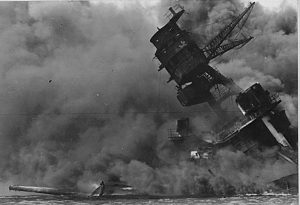
 other military equipment. After the attack, the people of the United States were…angry!! We quickly geared up and the war was on for the United States. Our delay could never bring back the people we lost, but we would certainly avenge their loss. Today we remember those we lost, and those who went out to take up the fight to protect our country from such a horrendous attack.
other military equipment. After the attack, the people of the United States were…angry!! We quickly geared up and the war was on for the United States. Our delay could never bring back the people we lost, but we would certainly avenge their loss. Today we remember those we lost, and those who went out to take up the fight to protect our country from such a horrendous attack.
 I had never heard the expression, “war sand” before, but when I think about it, the presence of it makes perfect sense. It would be impossible to have any kind of a battle and not leave behind spent bullets, as well as bits of shrapnel from bombs littering the battlefield. In the case of the D-Day Battle, there were more that 5,000 tons of bombs that littered the beaches of Normandy. The beaches were literal chaos, and it was all they could do to rescue the wounded, recover the bodies, and remove the equipment, much less save bits of metal and spent bullets left behind. On D-Day, more than 5,000 tons of bombs were dropped by the Allies on the Axis powers as part of the prelude to the Normandy landings…and then there was the bullets and such that hit the beaches during the battle.
I had never heard the expression, “war sand” before, but when I think about it, the presence of it makes perfect sense. It would be impossible to have any kind of a battle and not leave behind spent bullets, as well as bits of shrapnel from bombs littering the battlefield. In the case of the D-Day Battle, there were more that 5,000 tons of bombs that littered the beaches of Normandy. The beaches were literal chaos, and it was all they could do to rescue the wounded, recover the bodies, and remove the equipment, much less save bits of metal and spent bullets left behind. On D-Day, more than 5,000 tons of bombs were dropped by the Allies on the Axis powers as part of the prelude to the Normandy landings…and then there was the bullets and such that hit the beaches during the battle.
These days, scientists estimate that 4% of the Normandy beaches are made up of shrapnel from the D-Day Landings. They have studied the sand on the beaches of Normandy, and they’ve found microscopic bits of smoothed-down shrapnel from the landings. The sand on the Normandy beaches is known as “war sand,” which is defined as “sand that is a result from wartime operations.” I had heard of beaches that are made of glass that has been rubbed smooth by the water against the ground, but I hadn’t ever thought about the water being able to smooth the sharp bits of shrapnel to make them smooth. Nevertheless, the beaches of Normandy are  covered in a fine dust created from particles deposited there during or right before the D-Day operations of World War II. The grains are hidden among the beaches of the Normandy. It makes me wonder how many other beaches have shrapnel and bullets as a secret part of their makeup.
covered in a fine dust created from particles deposited there during or right before the D-Day operations of World War II. The grains are hidden among the beaches of the Normandy. It makes me wonder how many other beaches have shrapnel and bullets as a secret part of their makeup.
Earle McBride, a geologist from the University of Texas at Austin, figures the sands shrapnel level at 4%. That doesn’t seem like much, but considering the years since D-Day, and the number of people who have walked those beaches, possibly looking for closure concerning lost loved ones, 4% is quite a bit. One might wonder how he could have come to that conclusion, but apparently the sand-sized fragments of steel are magnetic, making them easily discernible under a microscope. Of course, there are still relics from the battle. The artificial landscape of eroded machinery is still detectable using special instruments in the coastal dunes.
The shrapnel content of the beaches will eventually disappear. It is estimated that at the present rate of deterioration, the magnetic particles will probably be wiped from the sands in another 100 years. The shrapnel is subject to waves, storms, and rust, which will wipe these spherical magnetic shards from the coasts. 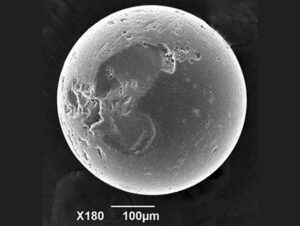 Strangely, Earle McBride didn’t set out to find these shards, but a visit to Omaha Beach in 1988 resulted in the discovery of these tiny remnants of shrapnel. I wonder how he noticed the shrapnel. Oddly, the shards were collected 20 years ago and only analyzed recently. Why did it take so long to examine them? Of course, I have answered my own question. While he may have known what he had, it is possible that he really didn’t or at least didn’t know the significance of what he had. He might have simply collected the sand as a keepsake of his visit. Nevertheless, upon examination, the samples revealed that the jagged-edged grains had a metallic sheen and a rust-colored coating. The angular grains proved to be magnetic…they proved to be shrapnel from that long ago battle.
Strangely, Earle McBride didn’t set out to find these shards, but a visit to Omaha Beach in 1988 resulted in the discovery of these tiny remnants of shrapnel. I wonder how he noticed the shrapnel. Oddly, the shards were collected 20 years ago and only analyzed recently. Why did it take so long to examine them? Of course, I have answered my own question. While he may have known what he had, it is possible that he really didn’t or at least didn’t know the significance of what he had. He might have simply collected the sand as a keepsake of his visit. Nevertheless, upon examination, the samples revealed that the jagged-edged grains had a metallic sheen and a rust-colored coating. The angular grains proved to be magnetic…they proved to be shrapnel from that long ago battle.
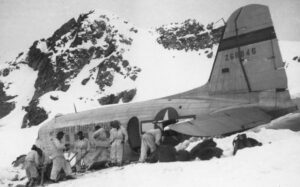
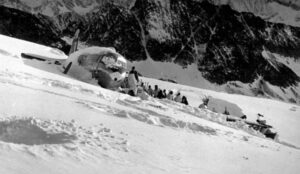 When Switzerland found itself in the middle of an unusual heatwave, the Gauli Glacier melted enough to uncover the wreckage debris of an American World War II plane that crash-landed in the Bernese Alps 72 years ago. Now, when you hear about the crash of a plane, especially into a mountain or in this case, a glacier, you expect to find fatalities. Of course, this plane crashed a long time ago, and the authorities already knew the outcome of that crash. The people who found the plane in the ice, however, might not have. This plane, a C-53 Skytrooper Dakota had been traveling from Austria to Italy when it collided with the Gauli Glacier at an altitude of 10,990 feet on that fateful day.
When Switzerland found itself in the middle of an unusual heatwave, the Gauli Glacier melted enough to uncover the wreckage debris of an American World War II plane that crash-landed in the Bernese Alps 72 years ago. Now, when you hear about the crash of a plane, especially into a mountain or in this case, a glacier, you expect to find fatalities. Of course, this plane crashed a long time ago, and the authorities already knew the outcome of that crash. The people who found the plane in the ice, however, might not have. This plane, a C-53 Skytrooper Dakota had been traveling from Austria to Italy when it collided with the Gauli Glacier at an altitude of 10,990 feet on that fateful day.
It was November 19, 1946, and the plane carrying four crew members and eight passengers were enjoying their trip, when something went terribly wrong. When they hit the glacier, several people were injured, amazingly, there were no fatalities. Among the passengers were high-ranking United States service members traveling with relatives…four women and one 11-year-old girl. Now, they found themselves high up on a glacier, and it was likely very cold. They were stuck at the crash site for six days before rescuers found them and could 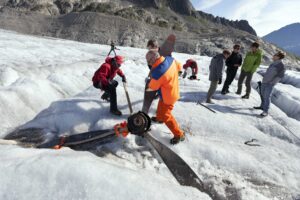
 get to them. They were forced to drink snow water and ration chocolate bars to survive, but survive they did. Many times, survival at a crash site, if you survived the initial crash, is all about using common sense and keeping your wits about you. You have to take stock of your supplies and be willing to ration what you have. You can’t let anyone get out of control, because a panic could waste vital supplies. Water is the most vital of the supplies, because while the human body can go weeks without food, it can only live a few days without water. While it would seem that water on a glacier would be plentiful, it may not be so. You would have to chip away at the ice, and then melt it to drink. In addition, you have to get it warm, or you will risk the water causing Hypothermia. This particular group managed to do things right, or at least enough right to survive the six days while they waited for rescue. Once rescued, they went on with their lives feeling very blessed to be alive.
get to them. They were forced to drink snow water and ration chocolate bars to survive, but survive they did. Many times, survival at a crash site, if you survived the initial crash, is all about using common sense and keeping your wits about you. You have to take stock of your supplies and be willing to ration what you have. You can’t let anyone get out of control, because a panic could waste vital supplies. Water is the most vital of the supplies, because while the human body can go weeks without food, it can only live a few days without water. While it would seem that water on a glacier would be plentiful, it may not be so. You would have to chip away at the ice, and then melt it to drink. In addition, you have to get it warm, or you will risk the water causing Hypothermia. This particular group managed to do things right, or at least enough right to survive the six days while they waited for rescue. Once rescued, they went on with their lives feeling very blessed to be alive.
The snow, and later, ice covered the plane as the years went by, and it was very likely forgotten…until 2012 anyway, when three young people discovered the plane’s propeller on the glacier. They continued to observe the emerging plane and as the glacier continued to melt, the scene unfolded. Today, it reportedly looks like a 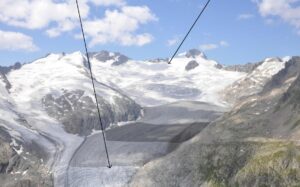
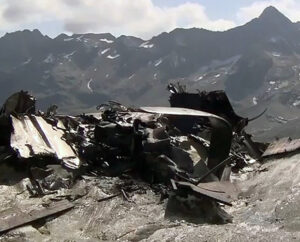 field covered in plane debris, and many people probably wonder how anyone managed to live through the initial crash…much less everyone. As the glacier melted, the plane slid down the mountainside and was expected to finally emerge at the bottom. In fact, much of the debris field might actually be caused by the melting ice.
field covered in plane debris, and many people probably wonder how anyone managed to live through the initial crash…much less everyone. As the glacier melted, the plane slid down the mountainside and was expected to finally emerge at the bottom. In fact, much of the debris field might actually be caused by the melting ice.
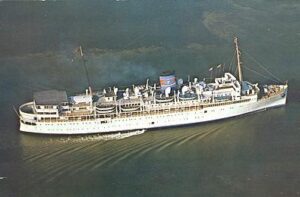 New safety laws usually come about as a direct result of a disaster or some other traumatic event. Such was the case with the laws formed after the fire and subsequent sinking of SS Yarmouth Castle. The ship was originally built as Evangeline, and it was an American steamship. It was the second of two identical ships built by the William Cramp and Sons Ship and Engine Building Company for the Eastern Steamship Lines for service on the New York City to Yarmouth, Nova Scotia route, operating in practice out of Boston as well. As with many ships, Evangeline was pulled into service during World War II and turned over to the War Shipping Administration, which operated all oceangoing vessels for the United States. During its war years, it was used primarily as an army troop transport. On July 1, 1946, after the war was over, Eastern Steamship Lines resumed control of the ship. Following its war service, it was put back in normal service for a short period and then, the ship was laid up. In 1954, it was sold and put under Liberian registry, operating from Boston to Nova Scotia, then to the Caribbean. In 1963 Evangeline was sold again, put under Panamanian registry. Then, it was renamed SS Yarmouth Castle. It was operated by Yarmouth Cruise Lines between Miami and Nassau, Bahamas, from 1964 until the disaster on November 13, 1965.
New safety laws usually come about as a direct result of a disaster or some other traumatic event. Such was the case with the laws formed after the fire and subsequent sinking of SS Yarmouth Castle. The ship was originally built as Evangeline, and it was an American steamship. It was the second of two identical ships built by the William Cramp and Sons Ship and Engine Building Company for the Eastern Steamship Lines for service on the New York City to Yarmouth, Nova Scotia route, operating in practice out of Boston as well. As with many ships, Evangeline was pulled into service during World War II and turned over to the War Shipping Administration, which operated all oceangoing vessels for the United States. During its war years, it was used primarily as an army troop transport. On July 1, 1946, after the war was over, Eastern Steamship Lines resumed control of the ship. Following its war service, it was put back in normal service for a short period and then, the ship was laid up. In 1954, it was sold and put under Liberian registry, operating from Boston to Nova Scotia, then to the Caribbean. In 1963 Evangeline was sold again, put under Panamanian registry. Then, it was renamed SS Yarmouth Castle. It was operated by Yarmouth Cruise Lines between Miami and Nassau, Bahamas, from 1964 until the disaster on November 13, 1965.
On November 12, 1965, Yarmouth Castle departed Miami for Nassau carrying 376 passengers and 176 crew members for a total of 552 people. The ship was due to arrive in Nassau the next day. The captain on the voyage was 35-year-old Byron Voutsinas. Shortly after midnight on November 13, a fire broke out in room 610 on the main deck. Being used as a storage space, the room was filled with mattresses, chairs, and other combustible materials. Unfortunately, the room did not have a sprinkler system, and in the end, the source of the fire could not be determined. It is thought that jury-rigged wiring might have thrown sparks that then entered the room through the ventilation ducts, but simple carelessness was not ruled out either.
A normal patrol went by the room between 12:30am and 12:50am, but they failed to systematically check all areas of the ship and detect the fire. At some point between midnight and 1:00am, the crew and passengers began noticing smoke and heat. Finally, a search was started to find the fire. By the time they discovered it in room 610 and the toilet above that room, it had already begun to spread and attempts to fight the fire with fire extinguishers were useless. Attempts to activate a fire alarm box were also unsuccessful. The bridge was unaware of the fire until about 1:10am, and by that time, Yarmouth Castle was 120 miles east of Miami and 60 miles northwest of Nassau, and in deep trouble. Since the radio room became involved, they were unable to call for help, or even call for the passengers to abandon ship.
The captain proceeded to the lifeboat containing the emergency radio, but he could not reach it. He and several crew members launched another lifeboat and abandoned ship at about 1:45am. The captain later testified that he wanted to reach one of the rescue vessels to make an emergency call. The remaining crew proceeded to alert passengers and attempted to help them escape their cabins. Some passengers tried to escape through cabin windows but couldn’t open them due to improper maintenance. The sprinkler system finally activated but was pretty much ineffective due to the severity of the fire. Crew members attempted to battle the flames with hoses, but they were hampered by low hydrant pressure. The investigation later determined that more valves were open than the pumps could handle.
Some of the lifeboats burned and others could not be launched due to mechanical problems. Only about half of the ship’s boats made it safely away. Passengers near the bow could not reach the lifeboats, but some were later picked up by boats from rescue vessels. The Finnish freighter Finnpulp was just eight miles ahead of Yarmouth Castle, also headed east. That ship’ crew noticed at 1:30am, that Yarmouth Castle had slowed significantly on the radar screen. Looking back, they saw the flames and notified their captain, John Lehto, who had been asleep. Lehto immediately ordered Finnpulp turned around. The Finnpulp successfully contacted the Coast Guard in Miami. It was the first distress call sent out. The passenger liner Bahama Star was following Yarmouth Castle at about twelve miles distance. At 2:15am, Captain Carl Brown noticed rising smoke and a red glow on the water. Realizing that this was Yarmouth Castle, he ordered the ship ahead at full speed. Bahama Star radioed the US Coast Guard at 2:20am.
Though rescue efforts were largely successful, for those who survived, 90 people lost their lives. Yarmouth 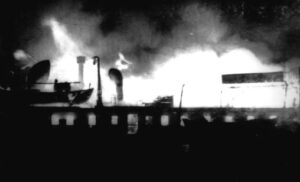 Castle capsized onto her port side just before 6:00am and sank at 6:03am. The wreck has not been located but is thought to rest 10,800 feet below the Atlantic. “The Yarmouth Castle disaster prompted updates to the Safety of Life at Sea law, or SOLAS. The updated law brought new maritime safety rules, requiring fire drills, safety inspections, and structural changes to new ships. Under SOLAS, any vessel carrying more than 50 overnight passengers is required to be built entirely of non-combustible materials such as steel. Yarmouth Castle’s largely wooden superstructure was found to be the main cause of the fire’s rapid spread.”
Castle capsized onto her port side just before 6:00am and sank at 6:03am. The wreck has not been located but is thought to rest 10,800 feet below the Atlantic. “The Yarmouth Castle disaster prompted updates to the Safety of Life at Sea law, or SOLAS. The updated law brought new maritime safety rules, requiring fire drills, safety inspections, and structural changes to new ships. Under SOLAS, any vessel carrying more than 50 overnight passengers is required to be built entirely of non-combustible materials such as steel. Yarmouth Castle’s largely wooden superstructure was found to be the main cause of the fire’s rapid spread.”
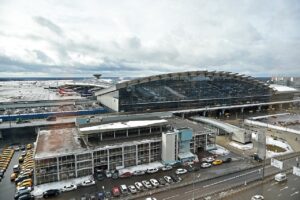 Vnukovo Airport was experiencing heavy fog on November 5, 1946. Due to the resulting low visibility conditions and a high number of aircraft bound for Moscow, including an Aeroflot LI-2 (registration CCCP-L4181) that was being ferried from Voronezh to Moscow. The LI-2, along with a number of other planes, were put in a holding pattern for 75 minutes. These things are a common practice, but maybe not for so long.
Vnukovo Airport was experiencing heavy fog on November 5, 1946. Due to the resulting low visibility conditions and a high number of aircraft bound for Moscow, including an Aeroflot LI-2 (registration CCCP-L4181) that was being ferried from Voronezh to Moscow. The LI-2, along with a number of other planes, were put in a holding pattern for 75 minutes. These things are a common practice, but maybe not for so long.
Finally, at 5:45pm, local time, the crew of the LI-2 was cleared to land and began their approach, still in a thick fog. It was a difficult approach, and the crew decided to go around. In all, five ADF approaches under radar guidance were attempted. Unfortunately, during the fifth approach the plane suffered fuel exhaustion. Immediately, the plane lost altitude and struck light poles and crashed. Fog creates very unique problems, and to complicate matters, that night three Aeroflot aircraft also crashed near Vnukovo Airport, killing a total of 19 occupants.
The first one, Aeroflot LI-2 (registration CCCP-L4181) crashed near Yamshchina, Moskovskaya, Russia. The determined cause was fuel exhaustion after being in a holding pattern for two hours, killing all five crew on board. Then, an Aeroflot C-47 (registration CCCP-L946) crashed in fog at Vnukovo Airport while attempting a go-around after being in a holding pattern for two hours, killing 13 of the 26 on board. Finally, an Aeroflot LI-2 (registration CCCP-L4207) crashed at Vnukovo Airport after repeated landing attempts due to fuel exhaustion after being in a holding pattern for 75 minutes, killing one of 26 on board.
The Vnukovo Airport is Moscow’s oldest operating airport. Originally opened for military operations during the Second World War, it became a civilian facility after the war. The Soviet government approved its construction in 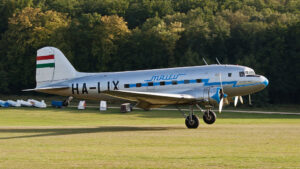 1937, because the older Khodynka Aerodrome, which was located much closer to the city center, was becoming overloaded. That airport closed by the 1980s. Vnukovo was built by several thousand inmates of Likovlag, which was a Gulag concentration camp created specifically for this purpose. Vnukovo opened on July 1, 1941. While the airport was old, it was not the cause of the November 5, 1946 crashes. More likely the pilots and flight controllers, who were preoccupied with the fog, simply forgot to monitor the fuel levels, and missed the fact that they were dangerously low. It is odd, however, that three were missed at the same time, and very sad that 19 people lost their lives because of it.
1937, because the older Khodynka Aerodrome, which was located much closer to the city center, was becoming overloaded. That airport closed by the 1980s. Vnukovo was built by several thousand inmates of Likovlag, which was a Gulag concentration camp created specifically for this purpose. Vnukovo opened on July 1, 1941. While the airport was old, it was not the cause of the November 5, 1946 crashes. More likely the pilots and flight controllers, who were preoccupied with the fog, simply forgot to monitor the fuel levels, and missed the fact that they were dangerously low. It is odd, however, that three were missed at the same time, and very sad that 19 people lost their lives because of it.

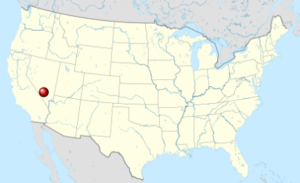 Our government has been known, in its history, to do some things that really were underhanded, and in some cases horrific. The “need” for nuclear bombs naturally facilitated the need for nuclear testing. I think everyone knows that would had to have happened, but on November 1, 1951, the US Army conducted nuclear tests in the Nevada desert that included a “diabolical exercise in which 6500 US Army troops were exposed to the effects of a nearby nuclear detonation and its associated radiation.” When I read that, I was furious. They knew what they were doing, and they did it as an experiment…just to see what would happen to those poor men.
Our government has been known, in its history, to do some things that really were underhanded, and in some cases horrific. The “need” for nuclear bombs naturally facilitated the need for nuclear testing. I think everyone knows that would had to have happened, but on November 1, 1951, the US Army conducted nuclear tests in the Nevada desert that included a “diabolical exercise in which 6500 US Army troops were exposed to the effects of a nearby nuclear detonation and its associated radiation.” When I read that, I was furious. They knew what they were doing, and they did it as an experiment…just to see what would happen to those poor men.
It was called Operation Buster–Jangle. The US Army conducted a series of 7 nuclear tests, that included the November 1st test. In that involuntary one test, the 6500 troops, were dug in foxholes and trenches only 6 miles from an air burst nuclear bomb of 21 kilotons yield. That is about the size of the Nagasaki bomb!! After the soldiers felt the hot nuclear wind blast over them, the wind deposited desert dust in choking clouds upon the men. Then, the soldiers were ordered to get up and march across the blast site to within 900 meters (a little over ½ a mile) of the nuclear “ground zero.” That is incredibly close, and those men were exposed.
The damage done to those men was not well documented, but the US Government later passed the 1990 Radiation Exposure Compensation Act (RECA) to compensate the military veterans exposed to nuclear testing in the 1950’s. The passing of that act is implied acknowledgment of the responsibility of the US government in long term health problems experienced by those troops…without actually placing the blame, and therefore opening the government up to future lawsuits. Basically, the men, were they still alive, or their families, if not, 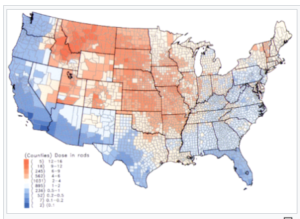
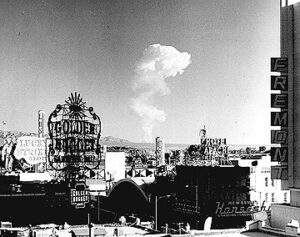 could theoretically be compensated for their losses. Of course, as many of us have seen with these kinds of cases, the process is very slow, the burden of proof for the men trying to receive compensation is heavy, and the final payout is usually quite low. RECA has awarded over $2.4 billion in benefits to more than 37,000 claimants since its inception in 1990. Still, that’s a small price to pay for the destruction of so many lives.
could theoretically be compensated for their losses. Of course, as many of us have seen with these kinds of cases, the process is very slow, the burden of proof for the men trying to receive compensation is heavy, and the final payout is usually quite low. RECA has awarded over $2.4 billion in benefits to more than 37,000 claimants since its inception in 1990. Still, that’s a small price to pay for the destruction of so many lives.
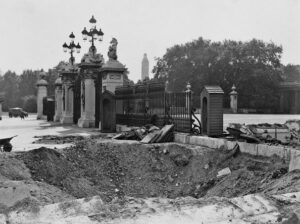 During World War II, the Third Reich run by Adolf Hitler was at war with the world, but at that point, mostly with the British, and especially the British Royal Family. There were a number of bombing campaigns that devastated London, but it was the attack of September 13, 1940, that managed to hit the mark that Hitler would consider, the jackpot. That bombing managed to hit Buckingham Palace. upon hearing that, I wondered, “Where was the family?” Many people tried to leave London, if they had the means. Many of the children were hidden on the country. The rest of the people hid wherever they could…in places like subway tunnels and such. Pretty much everyone had their windows blacked out at night, so that unless there was a moon, homes were well hidden. That summer the German army ramped up their attacks on Britain. London was the prime target of the pounding by the Luftwaffe. Called “The Blitz” attacks, the bombings were very damaging…destroying much of London’s infrastructure.
During World War II, the Third Reich run by Adolf Hitler was at war with the world, but at that point, mostly with the British, and especially the British Royal Family. There were a number of bombing campaigns that devastated London, but it was the attack of September 13, 1940, that managed to hit the mark that Hitler would consider, the jackpot. That bombing managed to hit Buckingham Palace. upon hearing that, I wondered, “Where was the family?” Many people tried to leave London, if they had the means. Many of the children were hidden on the country. The rest of the people hid wherever they could…in places like subway tunnels and such. Pretty much everyone had their windows blacked out at night, so that unless there was a moon, homes were well hidden. That summer the German army ramped up their attacks on Britain. London was the prime target of the pounding by the Luftwaffe. Called “The Blitz” attacks, the bombings were very damaging…destroying much of London’s infrastructure.
Well, the Royal Family certainly had the means to get out, so I assumed that they were in Scottland or somewhere when all this took place. As the leaders of the country, it would certainly make sense to get them to  safety. Nevertheless, when Buckingham Palace was bombed on September 13, 1940, Queen Elizabeth and King George VI were there. On that morning they were relaxing with a cup of tea, when they heard the ‘unmistakable whirr-whirr of a German plane’ and the ‘scream of a bomb’ that was followed by a rumble and a crash. A German raider had dropped five high explosive bombs on the Palace. The areas hit were the Royal chapel, inner quadrangle, Palace gates, and the Victoria memorial. Four members of the Palace staff were injured, one of whom died. Thankfully, the King and Queen went unharmed in the incident. Queen Elizabeth said in a poignant statement, ‘I am glad we have been bombed. It makes me feel I can look the East-End in the face.’ I’m sure he was just trying to be brave, because they were obviously quite shaken up. Her stance strengthened the reputation of the Royal Family in the eyes of the British public.
safety. Nevertheless, when Buckingham Palace was bombed on September 13, 1940, Queen Elizabeth and King George VI were there. On that morning they were relaxing with a cup of tea, when they heard the ‘unmistakable whirr-whirr of a German plane’ and the ‘scream of a bomb’ that was followed by a rumble and a crash. A German raider had dropped five high explosive bombs on the Palace. The areas hit were the Royal chapel, inner quadrangle, Palace gates, and the Victoria memorial. Four members of the Palace staff were injured, one of whom died. Thankfully, the King and Queen went unharmed in the incident. Queen Elizabeth said in a poignant statement, ‘I am glad we have been bombed. It makes me feel I can look the East-End in the face.’ I’m sure he was just trying to be brave, because they were obviously quite shaken up. Her stance strengthened the reputation of the Royal Family in the eyes of the British public.
This wasn’t the first attempt to take out the palace. Days earlier, on September 8th, a 50-kilogram bomb fell on the grounds of the Palace. That one malfunctioned, and didn’t explode, so it was later destroyed in a controlled explosion. Of course, the British Foreign Office immediately recommended that the family should leave the country for a time after the second bomb did so much damage, they refused, and it was viewed as a deep  “courage and a commitment to the United Kingdom” that the public appreciated. The Queen went on to say that “The children will not leave unless I do. I shall not leave unless their father does, and the King will not leave the country in any circumstances, whatever. So, it was settled. This act of defiance in the face of the German Blitz gave the country a much-needed boost in their war efforts. The people felt like they were not alone, and they gained a sense of unity throughout the United Kingdom. All of this happened during the Battle of Britain, which began on July 10, 1940. I would say that the efforts were greatly increased, because it ended on October 31, 1940, with a British victory.
“courage and a commitment to the United Kingdom” that the public appreciated. The Queen went on to say that “The children will not leave unless I do. I shall not leave unless their father does, and the King will not leave the country in any circumstances, whatever. So, it was settled. This act of defiance in the face of the German Blitz gave the country a much-needed boost in their war efforts. The people felt like they were not alone, and they gained a sense of unity throughout the United Kingdom. All of this happened during the Battle of Britain, which began on July 10, 1940. I would say that the efforts were greatly increased, because it ended on October 31, 1940, with a British victory.
 When the Germans surrendered at the end of World War II, Germany was divided into four areas of control by the Allied Powers…Great Britain in the northwest, France in the southwest, the United States in the south, and the Soviet Union in the east. Berlin, the capital city situated in Soviet territory, was also divided into four occupied zones. That gave those four countries governing control over their own sections of Germany, and the people in those areas. Not every country was exactly planning to do what the people might consider to be their best interests. The Allied countries had the control and the ability to dish out punishment as they saw fit. The Soviet Union considered the forced labor of Germans as part of German war reparations for the damage inflicted by Nazi Germany on the Soviet Union during the Axis-Soviet campaigns (1941-1945) of World War II. They wanted to exact some measure of revenge, I guess, and they were in a position to make that happen.
When the Germans surrendered at the end of World War II, Germany was divided into four areas of control by the Allied Powers…Great Britain in the northwest, France in the southwest, the United States in the south, and the Soviet Union in the east. Berlin, the capital city situated in Soviet territory, was also divided into four occupied zones. That gave those four countries governing control over their own sections of Germany, and the people in those areas. Not every country was exactly planning to do what the people might consider to be their best interests. The Allied countries had the control and the ability to dish out punishment as they saw fit. The Soviet Union considered the forced labor of Germans as part of German war reparations for the damage inflicted by Nazi Germany on the Soviet Union during the Axis-Soviet campaigns (1941-1945) of World War II. They wanted to exact some measure of revenge, I guess, and they were in a position to make that happen.
So, the Soviet authorities deported German civilians from Germany and Eastern Europe to the USSR after World  War II as forced laborers. It almost reminds me of what happened with the Holocaust, except that the Soviet Union had no interest in killing their captives. They wanted slave labor and a measure of retaliation. Ethnic Germans living in the USSR were conscripted for forced labor. German prisoners of war were also used as a source of forced labor during and after the war by the Soviet Union and by the Western Allies.
War II as forced laborers. It almost reminds me of what happened with the Holocaust, except that the Soviet Union had no interest in killing their captives. They wanted slave labor and a measure of retaliation. Ethnic Germans living in the USSR were conscripted for forced labor. German prisoners of war were also used as a source of forced labor during and after the war by the Soviet Union and by the Western Allies.
The decision was made and the fate of the German people was sealed. In 1946, the Soviet Union forcibly relocated more than 2,500 former Nazi German specialists, including scientists, engineers, and technicians who worked in specialist areas, from companies and institutions relevant to military and economic policy in the Soviet occupation zone of Germany (SBZ) and Berlin, along with around 4,000 family members, totaling more than 6,000 people, to the Soviet Union as war reparations. These specialists with all of their knowledge and abilities, could easily change the course of history in the Soviet Union, or any country they were placed in, for that matter. Still, not all of the forced labor were specialists. Many were unskilled labor, doing menial jobs.

The good thing was that the situation in Germany after World War II was appalling. Many of the people were homeless from the bombings. I suppose that, for that reason, the forced move, while scary, was not the worst thing in the world. It was possible that a new life in the Soviet Union could be favorable when compared to war-torn Germany. It is unclear whether any Germans who were sent to the Soviet Union chose to go back to Germany, because information about forced labor of Germans in the Soviet Union was suppressed in the Eastern Bloc until after the dissolution of the Soviet Union in 1991. Many of those records could have also been destroyed.

